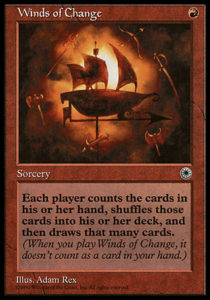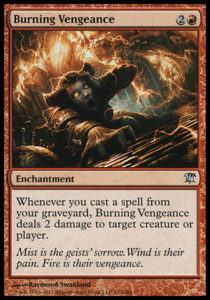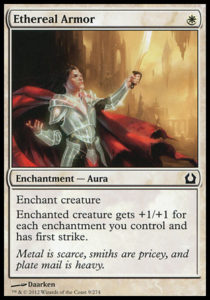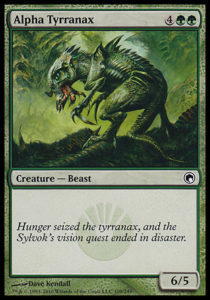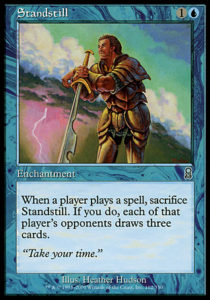Come next week, we’ll return to everyone’s favorite time*: preview season! It’s a time of staying up ’til midnight (if you’re in EST, like us) to check on the new goodies that each day brings, discussing what cards may break Standard or see play in Modern or be powerful in Limited, and speculating on what will be spoiled next.
(*Until the set comes out and we get to play with new cards.)
Theros’ spoiler season is unusual in that it follows the usual block structure (large—small—small), so each card previewed in Born of the Gods and Journey into Nyx will be added to the existing Theros Limited format, rather than replace it (as triple Gatecrash replaced triple Return to Ravnica). While this structure applied to every block since the first designed for Limited, Mirage, it has only been employed thrice in the past seven years (Shards of Alara, Scars of Mirrodin, and Theros). Lately, we’ve mostly had to think about large sets—Return to Ravnica, Gatecrash, Avacyn Restored, Magic 2014, and Modern Masters were completely new Limited formats and had to be figured out from scratch. I’d like to discuss how the addition of a small set changes an existing format.
While I’ve draft almost every full block format, I’ve only once had the opportunity to draft an L-S-S format as each set came out. That was back in 2010/2011 in Scars of Mirrodin when I returned to the game after over a decade off. I wrote about Mirrodin Besieged’s rotation in one of my first articles back in April. As I’ve only experienced a small set’s rotation once (well, twice if you count Dark Ascension and I wouldn’t count Dragon’s Maze as a usual kind of rotation) and that was when I was learning how to draft, I don’t consider myself a master on the subject and won’t go too far into depth of my expectations. I do, however, have some insights.
Archetypes that rely on a single card get weaker.
Wizards has been excellent at printing uncommon red enchantments in large sets that only work (but can work very well) in a deck built around them. I’m talking about Furnace Celebration, Burning Vengeance, Pyroconvergence, and perhaps the most awkward of all, Crackling Perimeter (which looked horrible until Jess demolished me in a DGM draft with her insane Hold the Gates deck at GP Providence). Other such gimmick/awesome decks include Spider Spawning, Ethereal Armor, and Angelic Accord.
When you add small sets, you dilute these archetypes; even if there are more sacrifice outlets for Furnace Celebration or multicolored enablers for Pyroconvergence, there’s an entire pack that will never contain those namesake cards. One might draft an amazing Burning Vengeance deck but never see a Burning Vengeance in only two packs of Innistrad. Without the namesake engine, the deck might not have enough or any win conditions. Alternative engines, like Secrets of the Dead, rarely match the power of the primary engine and are poor substitutes. Consequently, these namesake decks become increasingly poor draft choices as there’s no guarantee the necessary cards will be opened.
I’ve been wondering what the uncommon red enchantment was in Theros for some time and only recently did it hit me: Ordeal of Purphoros is the engine, hidden in a cycle of nearly identical engines. It doesn’t set up a gimmick deck, per say, but it enables brutally fast starts for heroic/aggro decks that many decks cannot recover from. Given that there are five times as many ordeals in Theros than there are Spider Spawnings in Innistrad, and that heroic/aggro decks can win just without any ordeals (and there is no ‘ordeal deck’), there’s no guarantee that Born of the Gods will dilute this Theros archetype much.
Archetypes that rely on multiple copies of a card or specific type of card get weaker
In triple Scars of Mirrodin, mana Myrs were plentiful. Players would routinely shave lands from their decks and still accelerate into four drops on turn three. When Mirrodin Besieged came out, suddenly mana Myrs weren’t quite so abundant. Without anything to replace them in Besieged, mana Myr became higher draft picks and the loss of acceleration (combined with another factor, discussed below) slowed the format down.
The best white common creature is Wingsteed Rider (though Hopeful Eidolon is up there). It’s an irreplaceable component of white heroic decks. Without it and powerful higher rarity cards like Favored Hoplite, white aggro has to rely on cards like Cavalry Pegasus, which can be potent in a WU/RW heroic deck but is a puny 1/1 for two by itself. With one fewer pack of Theros, there will be one fewer pack of Wingsteed Riders. I wonder if something similarly powerful will fill its slot in Born of the Gods, and there isn’t, I’d expect white heroic to get a bit weaker.
Power level increases
This might be unique to my experience with Scars block, but the power level of the set increased dramatically as additions were made. In full block draft, New Phyrexia and Mirrodin Besieged so eclipsed Scars of Mirrodin that previously top tier commons like Plague Stinger (black’s infect cards were much weaker in NPH and MBS) and Shatter (Glissa’s Scorn and Divine Offering meant red had lost its monopoly on good artifact removal and decks like dinosaurs blacked that removal entirely) weren’t impressive and decent cards, like Chrome Steed (a core component of metalcraft, a mostly dead deck), were hardly playable.
I encountered less of this in Dark Ascension, which added powerful cards that tipped the scales to favor previously weak/difficult color combinations, like RG, WB, and RW, as well as bolstered the power level of Innistrad’s weakest color, red. I’m curious what the format would have looked like had Avacyn Restored been a large set and there were two sets with common undying creatures. Perhaps Innistrad bucked what I saw in Scars of Mirrodin and didn’t increase its power level. Perhaps formats tend to increase in power as the complexity and number of set mechanics increase. Perhaps the lower odds of drafting any specific cards increases the quantity of slower ‘good stuff’ decks (it certainly happened in Dragon’s Maze).
I’m not certain just what Born of the Gods will bring (other than new cards, multicolored gods, and my favorite Duelswalker, Kiora Atua), but I’m excited to find out. Change is good and provides us the opportunity for discovery. I’ll see you next week to chat about Born of the Gods. As always, thanks for reading.
—Zachary Barash
twitch.tv/ZennithGP — Join the livestream!
Magic Online username: Zennith
Zachary Barash has been playing Magic on and off since 1994. He loves Limited and drafts every available format (including several that aren’t entirely meant to be drafted). He’s a proud Cube owner and performer, improvising entire musicals every week with his team, Petting Zoo. Zach has an obsession with Indian food that borders on being unhealthy.

